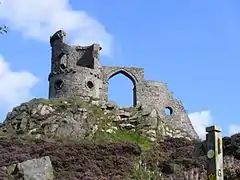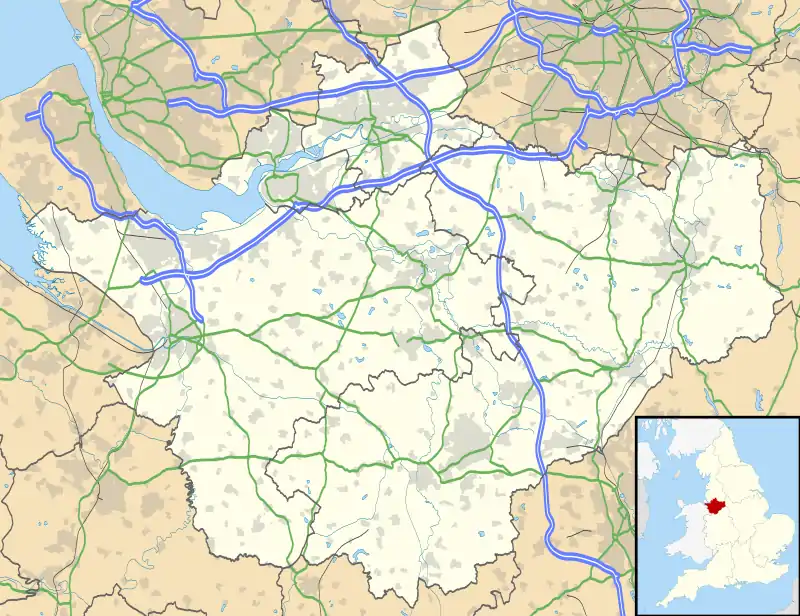Mow Cop
Mow Cop /ˈmaʊˈkɒp/ is a village on the Cheshire–Staffordshire border, divided between the North West and West Midlands regions of England. It is 24 miles (39 km) south of Manchester and 6 miles (9.7 km) north of Stoke-on-Trent, on a steep hill of the same name rising up to 335 metres (1,099 ft) above sea level.[1] The village is among the westernmost hills of the Staffordshire Moorlands, with the Cheshire Plain directly to the west. For population details taken at the 2011 census, see Kidsgrove.
| Mow Cop | |
|---|---|
 Mow Cop Castle | |
 Mow Cop Location within Cheshire | |
| OS grid reference | SJ855573 |
| Civil parish | |
| District | |
| Unitary authority | |
| Shire county | |
| Ceremonial county | |
| Region | |
| Country | England |
| Sovereign state | United Kingdom |
| Post town | STOKE-ON-TRENT |
| Postcode district | ST7 |
| Dialling code | 01782 |
| Police | Cheshire |
| Fire | Cheshire |
| Ambulance | North West |
| West Midlands | |
| UK Parliament | |
Geography
The 335-metre (1,099 ft) hill on which the village lies upon is a moorland ridge composed of sandstone and Millstone Grit rising eastwards above the Cheshire Plain. It is at the western edge of the Staffordshire Moorlands, forming the upland fringe of the southern Pennines, most of which are in the Peak District National Park to the east.[2] On a clear day, the hill offers views extending to the West Pennine Moors, Welsh mountains (including Snowdonia), Shropshire Hills and Cannock Chase.
History
The name is first recorded as Mowel around 1270 AD, and is believed to derive from either the Anglo-Saxon Mūga-hyll, meaning "heap-hill", with copp = "head" added later, or the Common Celtic ancestor of Welsh moel (= hill), with Anglo-Saxon copp added later.[3]
At the village's summit, men once quarried stone to make into querns, used since the Iron Age for milling corn; this trade ended during the Victorian period. The village also has a long history of coal mining. A 65-foot (20 m) rock feature called the Old Man O'Mow in one of the quarried areas is believed to be the site of an ancient cairn.
A railway station, opened by the North Staffordshire Railway, served the village from October 9, 1848 to its closure in 1964.
The Castle
The most dominant feature of the village is Mow Cop Castle, a folly of a ruined castle at the summit of the hill, built in 1754. Both Mow Cop Castle and the Old Man O'Mow are under the management of the National Trust, and on the route of the Cheshire Gritstone Trail, a long-distance walking route.
Birthplace of Primitive Methodism
Mow Cop is noteworthy as the birthplace of the Primitive Methodist movement. Starting in 1800, Hugh Bourne from Stoke-on-Trent and William Clowes from Burslem began holding open-air prayer meetings. On 31 May 1807, a large 14-hour camp meeting was held, leading to the founding of the Primitive Methodist Church in 1810. These camp meetings became a regular feature at Mow Cop, being held to celebrate the 100th, 150th and 200th anniversaries of the first camp.[4]
In the arts
The village and castle are featured prominently in the 1973 novel Red Shift, by Alan Garner. This novel was filmed by the BBC in the 1970s, and later released in a restored HD DVD in 2014. Mow Cop and its castle also feature in Alan Garner's 1966 photo-story book for children, The Old Man of Mow.
The castle has also been a magnet for artists, and can be seen in everything from local watercolour and oil paintings and postcards, to ceramics made in the nearby Potteries. An engraving of it also featured on a Royal Mail stamp book in 1981.
Running and cycling
Since the late 20th century, Mow Cop has been known for its Killer Mile, a one-mile running race from the railway level crossing on the western side of the hill up to the castle. The race was first organized in the early 1980s by John Britton.[5] The climb is also well known among local cyclists and features in the 100 Greatest Cycling Climbs in Britain.[6]
Murder of Steven Johnson
On 22 December 1990, the body of Stoke-on-Trent taxi driver Steven Johnson, a 25 year-old married father of two children, was discovered by a dog-walker on a farm track near Castle Road in Mow Cop. His body was found close to his taxi. Johnson had last been seen picking up a fare in Hanley Road, Hanley to be dropped off in Packmoor at around 3:30AM on 22 December. He then drove from Packmoor to Mow Cop. Johnson had been assaulted inside his taxi and his throat was cut, causing his death. It was reported by Staffordshire Police that cash and valuables were not taken from the taxi and motive for the murder was unknown. The crime was featured in the March 1991 edition of BBC Crimewatch and a reconstruction was filmed. One male suspect was arrested in 2014[7] and released on bail for five months, but no further action followed. The murder remains unsolved as of November 2020.[8]
Notable residents
- Ralph Barlow (1876 in Mow Cop – 1897), footballer who played for Burslem Port Vale in the mid-1890s.
- Emmanuel Foster (1921–1965), English footballer, played for Mow Cop, Stoke City F.C. and Stafford Rangers F.C.
- Alan Jones (born 1945), former director of Port Vale F.C.
- Jack Simcock (1929–2012), artist, known for "a long series of bleak, sombre oils on board" of the Mow Cop area where he lived.
- Allen John Tankard (born 1969), English former footballer who played 519 league games, 275 for Port Vale. After retiring he worked in Mow Cop at a minibus and coach hire company which he now co-owns.
References
- "Mow Cop - Trig Point". Hill Bagging. Retrieved 29 April 2016.
- "Potteries and Churnet Valley". Scottish Natural Heritage. Archived from the original on 2 June 2016. Retrieved 3 May 2016.
- Kent, Jeff (2013). Staffordshire's 1,000-Foot Peaks. Witan Books. ISBN 978-0-9927505-0-3.
- Farndale, W. E. (1950). The Secret of Mow Cop: A New Appraisal of the Origins of Primitive Methodism. London: Epworth Press.
- "Killer Mile". www.mowcop.info. Mow Cop Residents Association. Retrieved 30 June 2015.
- Warren, Simon (2010). 100 greatest cycling climbs: A road cyclist's guide to Britain's hills. London: Frances Lincoln. ISBN 9780711231207.
- "Stoke-on-Trent man arrested in 1990 Steven Johnson death probe". BBC News. 18 June 2014. Retrieved 20 November 2020.
- Parker, Hayley (22 December 2019). "29 years on: Family release new photo of cabbie whose killer is still at large". StokeonTrentLive. Retrieved 20 November 2020.
The following references are listed in the two books by Philip R. Leese:
- Deardon, John (1986). Tale of the Backbone: Journey Along the Watershed of England. Book Guild. ISBN 0863321380.
- Garner, Alan; Hill, Roger (1966). The Old Man of Mow. Collins. ASIN B005OH72RS.
- Harper, W. J. (1907). Mow Cop and its Slopes: A Short History. The Local Herald. ASIN B004X2F04C.
- Hoskins, W. G.; Grigson, Geoffrey (1951). Chilterns to Black Country. About Britain. 5. Collins. ASIN B0006D9DKY.
- Kennedy, J., ed. (1980). Biddulph ("By the Diggings"): A Local History. Dept. of Adult Education, Keele University. ASIN B001OK2LSE.
- Rowley, F. (c. 1907). Rowley's Photographic Centenary Souvenirs: Historic Mow Cop and Early Primitive Methodism. Biddulph: F. Rowley.
- Simcock, J. (1975). Simcock, Mow Cop. self-published.
- Walford, John (2011) [1854]. Memoirs of the Life and Labours of the Late Venerable Hugh Bourne: By a Member of the Bourne Family. Cambridge University Press. ISBN 110802498X.
- Wilkes, Arthur; Lovatt, Joseph (1942). Mow Cop and the Camp Meeting Movement: Sketches of Primitive Methodism. Orphans' Printing Press Ltd. ASIN B002A8PCY4.
- Leese, Philip R. (2010). Mow Cop: A Working Village. Churnet Valley Books. ISBN 9781904546726. Covers quarrying, coal mining, fustian, farming, shops and small businesses, and public houses.
- Leese, Philip R. (2011). Mow Cop: Living on the Hill. Churnet Valley Books. ISBN 9781904546764. Covers social life, literary references to the hill, the Castle, the Mow Cop Giantess (Hannah Dale), Primitive Methodism, chapels, churches, schools, recreation, wartime reminiscences, and the artist Jack Simcock.
External links
| Wikimedia Commons has media related to Mow Cop. |